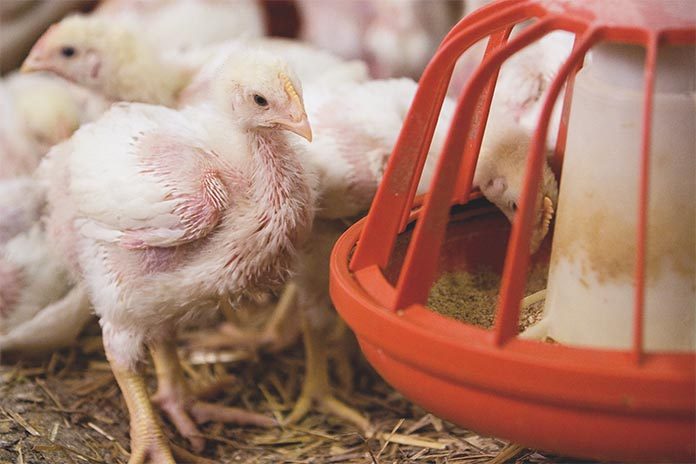
Dramatic antimicrobial usage changes and improved antimicrobial stewardship.
The new report shows dramatic reductions of turkey and broiler chicken antimicrobial use over a five-year timeframe. As part of its commitment to the transparency and sustainability of a safe food supply, the poultry industry aims to strike a balance between keeping poultry flocks healthy and the responsible use of antimicrobials, especially those medically important to human health.
Under the research direction of Dr. Randall Singer, DVM, PhD, of Mindwalk Consulting Group, LLC, this report represents a five-year set of data collected from 2013 to 2017 regarding the use of antimicrobials in U.S. broiler chickens and turkeys throughout their lifetime, from hatchery to day of harvest. It was prepared through a systematic collection of on-farm antimicrobial use data to capture the disease indications and routes of administration through which antimicrobials were given to the poultry.
Given several key differences among broiler chickens and turkeys – namely differences in weight, life span, susceptibility to lifetime illness and the number of effective medical therapies available – the data from broiler chickens and turkeys should neither be combined nor compared.
Key changes among broiler chickens over the five-year period show:
- Broiler chickens receiving antimicrobials in the hatchery decreased from 93% to 17%.
- Hatchery gentamicin use decreased approximately 74%.
- Medically important in-feed antimicrobial use in broiler chickens decreased by as much as 95%. For example: tetracycline 95%, virginiamycin 60%.
- Medically important water-soluble antimicrobial use in broiler chickens decreased by as much as 72%. For example: penicillin 21%, tetracycline 47%, sulfonamide 72%.
- There was a documented shift to the use of antimicrobial drugs that are not considered medically important to humans (e.g., avilamycin and bacitracin BMD).
Key changes among turkeys over the five-year period show:
- Turkeys receiving antimicrobials in the hatchery decreased from 96% to 41%.
- Hatchery gentamicin use decreased approximately 42%.
- Medically important in-feed antimicrobial use in turkeys decreased: tetracycline 67%.
- Medically important water-soluble antimicrobial use decreased substantially. For example: penicillin 42%, tetracycline 28%, lincomycin 46%, neomycin 49%, erythromycin 65%.
Antimicrobial use among broiler chickens and turkeys decreased dramatically between 2013 and 2017, and there are a couple of key explanations for this:
- Changes in FDA regulations, which were fully implemented in January 2017, effectively eliminated the use of medically important antimicrobials for production purposes and placed all medically important antimicrobials administered in the feed or water of poultry under veterinary supervision.
- A continued focus by poultry companies on disease prevention, thereby reducing the need for antimicrobials.
- Improved record-keeping of all antimicrobial administrations, which is a key component of antimicrobial stewardship.
Furthermore, the broiler chicken and turkey industries have increased the production of animals raised without antimicrobials.
Participation in this effort was entirely voluntary. The poultry industry recognized the importance of this work and responded. The 2017 data in this report represent more than 7.5 billion chickens (about 90% of annual U.S. chicken production by the major companies on the WATT PoultryUSA list) and 160 million turkeys (about 80% of annual U.S. turkey production by the major companies on the WATT PoultryUSA list).
USPOULTRY Vice President of Research, Dr. John Glisson, DVM, MAM, PhD, affirms, “This research is the first step in determining how antimicrobials are used in the entire poultry production system of the U.S., and to succeed, we need participation from the majority of companies. We couldn’t be more pleased with the response of the poultry industry.”
Glisson cautions, though, that there are still serious bird illnesses (e.g., necrotic enteritis, gangrenous dermatitis and colibacillosis) for which the poultry industry has few effective interventions. And when birds get sick from these diseases, they must receive therapy. He confirms that “driving good antimicrobial stewardship in poultry, as opposed to simple documentation of reduced use, is our end goal for the best outcomes for both the people and the poultry.”
Moving forward in 2019, Dr. Singer will continue the annual collection of data from the broiler chicken and turkey industries and will begin collecting data from the U.S. table egg industry. Glisson anticipates this new data will provide greater clarity about antimicrobial use in individual flocks, stating, “We expect even more detailed data on flock antimicrobial usage and record-keeping in the years ahead, which thoroughly supports USPOULTRY efforts to ensure proper stewardship of medications.”

















